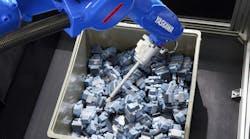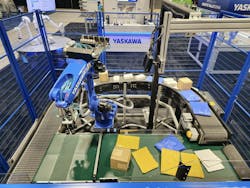At Automate 2024, two demos at Yaskawa’s booth—illustrating the importance of real-time vision systems and high-speed picking capabilities—make Machine Design’s pick of the day.
Application No. 1: Parcel Induction and Simulation
In an order fulfilling demonstration, a six-axis Yaskawa GP12 robot is paired with a PickOne AI-powered induction software from Plus One Robotics. Random packages that are predefined or appear in random orientations move along a conveyor. The robot must latch onto the positions of the packages in real time and, without losing any speed, handle a wide variety of packages.
A variety of parcels are used to simulate what one might see in order fulfilling stations at a FedEx or UPS facility, according to Chris Caldwell, product manager at Yaskawa Motoman. Their businesses are high speed, but they also have a human in the loop,” he said.
Speed is an important characteristic. The platform showed a pick rate of between 16,000 and 17,000 per hour for a variety of products in the cell. The AI-powered vision system enables 2D images of items, in addition to their 3D geometric surfaces, edges and corners.
READ MORE: Standing-Room-Only Turnout at Tuesday’s Automate Keynote
Caldwell said the vision system can produce a pick for most items, but in the rare case that it doesn't, it fires off a “yonder call” to either a trained employee, or an off-site monitoring service. “Typically, one human can monitor between 10 and 20 cells and, within 30 seconds the employee will be able to interact with a call instructing the robot what to do and get that robot back up and running,” said Caldwell.
Robots and automation have for a long time tended to be operated on predefined points, whereby they were programmed with hundreds or thousands of individual points. “That type of automation has reached its peak,” said Caldwell.
The industry has seen growth in this specific application, according to Caldwell, especially with all parcel carriers, third-party logistics companies and e-commerce fulfillment centers. The benefit of the automated solution is that they can achieve very high pick rates each hour and need to set aside a small floorplan.
Application No. 2: Fast, Accurate Robotic Bin Picking
The demo featured a Keyence 3D vision system and relied on a predefined CAD model of the parts. An image sensor located above the cell projected light and detected objects contained in the bin.
“With their setup program, we load the robot model and end effector details,” explained Caldwell. “It does all of the path planning and collision avoidance.”
READ MORE: Automate 2024 Opens to Enthusiastic Crowd
A very long gripper ensures the end effector can go deep into the bin and turn once inside, without running into edges. The robot distinguishes between objects (in this case, miniature toy robots) that have a very small difference and are programmed to be placed face up and face down. The robot meticulously selected parts and placed a set of robots face up on one tray and face down on a second tray.
Cycle time is a bit slower than the AI-powered induction, said Caldwell, but it addresses the key thing that people frequently look for: ease of use and setup. In addition, being able to pick deep into the bin, all the way to empty, is another feature when there are several thousand pieces of goods in a bin. The hardest parts to pick are the top 5% and the bottom 10%. “That’s because you start running out of potential pics and you get into orientations and laying in a shadow up against the wall,” said Caldwell. This solution, he said, picks until the bin is completely empty.

